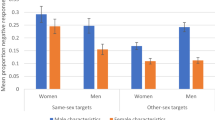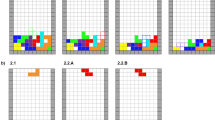Abstract
This study explores the effects of context on cross-sex dominance. An emerging finding in the sex differences literature is that boys are often more successful than girls at influencing members of the other gender. As a result, boys tend to get more than their share of a scarce resource in mixed-sex situations. Because the presence of adults inhibits just those strategies that boys use successfully when dominating girls, we hypothesize that the presence of an adult will reduce or eliminate the sex difference in access to a scarce resource. This should be particularly true for tasks in which boys' strategies are most likely to be effective. To test this hypothesis, dominance (as evidenced by asymmetry in gaining access to a scarce resource) was measured while 48 boy-girl pairs, ranging in age from 42 to 60 months, negotiated turn taking at a movie viewer in either the presence or absence of an adult (adult location factor) in a situation that either did or did not require the cooperation of the second child in order to see cartoons (task type factor). For the cooperative task, neither sex significantly dominated the other in either the presence or absence of the adult. In contrast, for the competitive task, boys dominated in the absence of the adult. When the adult was present, however, boys and girls shared more equally. An examination of the strategies children used in the competitive task indicated that boys were inhibited in the adult's presence, dropping their rate of demands and giving girls longer turns. Implications for gender segregation and for sex differences in seeking proximity to adults are discussed.
Similar content being viewed by others
References
Brody, G. H., Stoneman, Z., & Wheatley, P. (1984). Peer interaction in the presence and absence of observers. Child Development, 55, 1425–1428.
Carpenter, C. J., Huston, A. C., & Holt, W. (1986). Modification of preschool sex-typed behaviors by participation in adult structured activities. Sex Roles, 14, 603–615.
Carpenter, C. J., & Huston-Stein, A. (1980). Activity structure and sex-typed behavior in preschool children. Child Development, 51, 862–872.
Charlesworth, W. R., & Dzur, C. (1987). Gender comparisons of preschoolers' behavior and resource utilization in group problem-solving. Child Development, 58, 191–200.
Charlesworth, W. R., & LaFreniere, P. (1983). Dominance, friendship, and resource utilization in preschool children's groups. Ethology and Sociobiology, 4, 15–26.
Eagly, A. H. (1987). Sex Differences in social behavior: A social role interpretation. Hillsdale, NJ: Lawrence Erlbaum Associates.
Eaton, W. O., & Enns, L. R. (1986). Sex differences in human motor activity level. Psychological Bulletin, 100, 19–28.
Fagot, B. I. (1977). Consequences of moderate cross-gender behavior in preschool children. Child Development, 48, 902–907.
Fagot, B. I. (1985). Beyond the reinforcement principle: Another step toward understanding sex role development. Development Psychology, 21, 1097–1104.
Hartup, W. W. (1983). Peer relations. In H. Mussen (Ed.), Handbook of child psychology (4th ed., Vol. 4).
Hartup, W. W., Moore, S. G., & Sager, G. (1963). Avoidance of inappropriate sex-typing by young children. Journal of Consulting Psychology, 27, 467–473.
Hinde, R. A., Easton, D. F., Meller, R. E., & Tamplin, A. (1983). Nature and determinants of preschooler's differential behavior to adults and peers. British Journal of Developmental Psychology, 1, 3–19.
Huston, T. L. (1983). Power. In H. H. Kelley, E. Berscheid, A. Christensen, J. H. Harvey, T. L. Huston, G. Levinger, E. McClintock, C. A. Peplau, & D. R. Peterson (Eds.), Close relations. New York: W. H. Freeman.
Jacklin, C. N., & Maccoby, E. E. (1978). Social behavior at thirty-three months in same-sex and mixed-sex dyads. Child Development, 49, 557–569.
LaFreniere, P. J., & Charlesworth, W. R. (1987). Preschool peer status, behavior and resource utilization in a cooperative/competitive situation. International Journal of Behavioral Development, 10, 345–358.
LaFreniere, P., Strayer, F. F., & Gauthier, R. (1984). The emergence of same-sex preferences among preschool peers: A developmental ethological perspective. Child Development, 55, 1958–1965.
Langlois, J. H., & Downs, A. C. (1980). Mothers, fathers, and peers as socialization agents of sex-typed play behaviors in young children. Child Development, 51, 1217–1247.
Leimbach, M. P., & Hartup, W. W. (1981). Forming cooperative coalitions during a competitive game in same-sex and mixed-sex triads. The Journal of Genetic Psychology, 139, 165–171.
Lott, B. (1978). Behavioral concordance with sex role ideology related to play areas, creativity, and parental sex typing of children. Journal of Personality and Social Psychology, 36(10), 1087–1100.
Maccoby, E. E. (1988). Gender as a social category, Developmental Psychology, 24, 755–765.
Maccoby, E. E., & Jacklin, C. N. (1974). The psychology of sex differences. Stanford, CA: University Press.
Maccoby, E. E., & Jacklin, C. N. (1987). Gender segeregation in childhood. In H. Reese (Ed.), Advances in child development and behavior (Vol. 20). New York: Academic Press.
Oettinger, G. (1985). The influence of the kindergarten teacher on sex differences in behavior. International Journal of Behavioral Development, 8, 3–13.
Serbin, L. A., Connor, J. M., & Citron, C. C. (1981). Sex-differentiated free play behavior: Effects of teacher modeling, location, and gender. Developmental Psychology, 17, 640–646.
Serbin, L., Sprafkin, C., Elman, M., & Doyle, A. B. (1984). The early development of sex differentiated patterns and social influence. Canadian Journal of Social Science, 14(4), 350–368.
Siegel, A., & Kohn, L. (1959). Permissiveness, permission, and aggression: The effect of adult presence or absence on aggression in children's play. Child Development, 30, 131–141.
Author information
Authors and Affiliations
Rights and permissions
About this article
Cite this article
Powlishta, K.K., Maccoby, E.E. Resource utilization in mixed-sex dyads: The influence of adult presence and task type. Sex Roles 23, 223–240 (1990). https://doi.org/10.1007/BF00290045
Issue Date:
DOI: https://doi.org/10.1007/BF00290045




